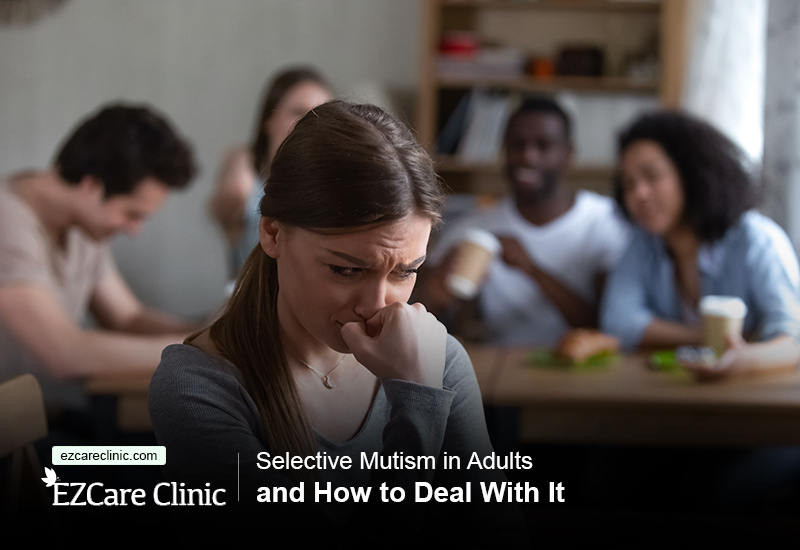Selective mutism is a unique type of anxiety or social anxiety that commonly occurs during childhood. However, if not treated, it can continue through adulthood.
Sometimes referred to as situational mutism, the disorder is often suspected in cases where a child or adult avoids speaking in certain situations for fear of being judged or criticized.
Adults and children who suffer from selective mutism have great difficulty in social settings.
They feel uncomfortable, which makes it difficult for them to communicate and adjust to such settings. For this reason, selective mutism frequently occurs with social anxiety disorder.
Of all the professional treatments available, get the most suitable selective mutism treatment by a mental health professional at EZCare Clinic- Click below.
Despite selective mutism’s significant impact on mental health, very few are aware of what this condition entails.
The following guide will help you understand the nature of the condition and how its symptoms can be managed effectively.
1. Symptoms of Selective Mutism in Adults
Selective mutism typically starts between the ages of two and four. It’s often recognized as children start to engage with individuals outside of their immediate families, such as when they begin preschool or elementary school.
The most obvious warning sign is a dramatic disparity in the child’s ability to engage with other people. Instead, they may react with sudden silliness or a frozen facial expression when they are expected to speak with someone outside their comfort zone.
When left untreated, selective mutism can progress into adulthood or result in
-
Signs of Selective Mutism in Adults
Adults who are selectively mute in uncomfortable situations often dread being judged. Therefore, they do not talk in those situations.
There are multiple behavior signs that may accompany the trait of mutism that could indicate adult selective mutism, including:
- Avoiding eye contact
- Stiff, tense, and poor coordination
- Irritability, rudeness, and disinterest
- Clinginess
- Stubborn or violent, becoming enraged when challenged by others or throwing temper tantrums after returning home from work
- Shy and withdrawn
Adults with selective mutism who have more confidence may choose to use gestures to communicate.
For instance, they may nod for yes or shake their head for no. However, those who are more severely affected often tend to avoid any form of communication, whether spoken, written, or gestured.
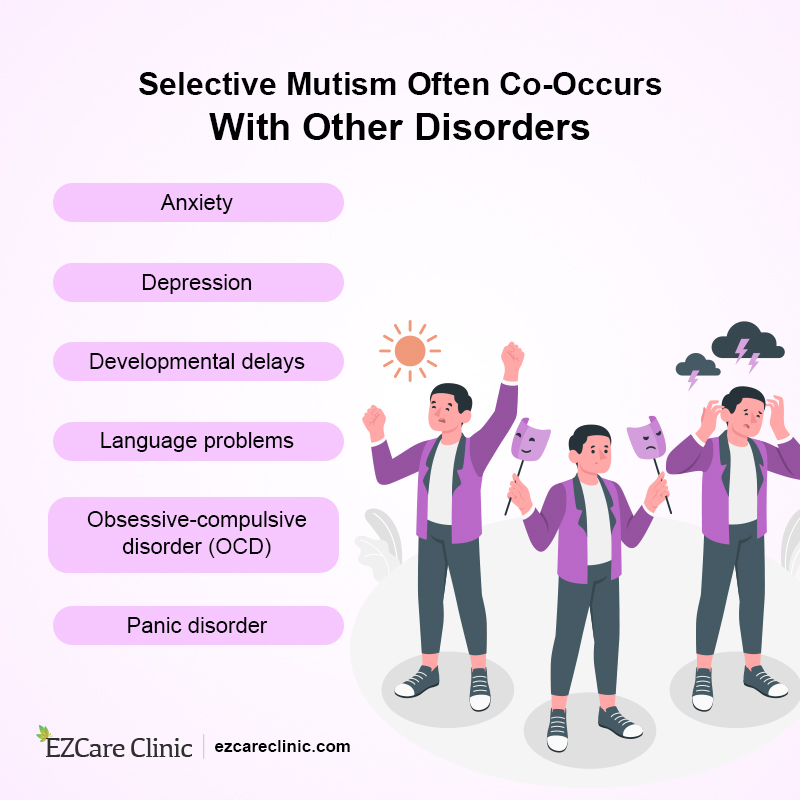
Selective Mutism and Other Disorders
-
Behaviors Associated With Selective Mutism
Selectively mute adults often adopt strategies to escape or avoid fear-inducing speaking situations.
For example, the adult may:
- Physically remove themselves from speaking situations
- Freeze in place
- Avoid eye contact
- Try to hide
- Throw tantrums
- Decline invitations to social events
- Develop psychosomatic illnesses, such as a stomach ache or headache
-
An Example Case Study of a Nepali Soldier
The following case study may help provide an accurate depiction of an adult with selective mutism.
During his advanced individual training, a 22-year-old male soldier who had recently immigrated from Nepal displayed unusual behavior and autism.
As a result, he was moved to a psychiatric medical center for further examination and treatment after receiving care from a hospital near his unit.
A diagnosis of selective mutism was made after considering cultural factors and ruling out concurrent thought disorder.
When he first arrived at his duty station, he regularly spoke English and had completed his initial training without incident.
However, during his advanced training, his use of the English language dramatically decreased. He also became increasingly isolated.
When presented for evaluation, he was noted to be mute. The soldier had immigrated to the United States from Nepal.
The change to living in another country and a controlled military lifestyle created significant challenges and difficulties for the soldier, which resulted in mutism.
2. Diagnosis and Facts Regarding Selective Mutism in Adults
Selective mutism is a very real condition. If left untreated, it may lead to further emotional and mental conditions, such as low self-esteem, isolation, and social anxiety disorder. As adults, we are expected to engage in social situations more often.
We have to work, make a living and be more confident. Therefore, selective mutism needs to be recognized early by adults and their loved ones to promptly address anxiety.
The diagnosis of social anxiety disorder is based on the description of the symptoms you provide to your healthcare professional. Click below to schedule your appointment.
-
Diagnosing Adult Selective Mutism
Specific guidelines are used to identify selective mutism.
The following behaviors could show an individual may have this condition, such as:
- Not speaking in some settings, such as during college classes or in public places where they can be overheard: but able to communicate in contexts where they are at ease, such as at home with their parents or an empty classroom or bedroom.
- An inability to speak to certain people that lasts for at least one month or two months in a new setting inhibits their ability to function in that setting.
- Their inability to speak is not explained by another behavioral, mental, or communication disorder.
-
Consequences of Selective Mutism
Adults with selective mutism often have other fears, social anxieties, or additional speech and language difficulties. They’re often wary of doing things that draw attention to them because they think people will expect them to talk.
For example, when seeing other colleagues asked to present their work, someone with selective mutism may feel anxious and cannot do the same.
The pressure to present work and talk in front of their colleagues with all eyes on them can trigger stress and inability to speak. They may be afraid to change their routines because it could provoke comments or questions. Many have an overall fear of making a mistake.
Adults with selective mutism might find it difficult to learn or complete assignments because they cannot ask questions in class. Therefore, this condition could affect their academic and professional growth.
Because teenagers with selective mutism may be afraid to leave their house on their own, they may not develop independence as they reach adulthood.
Adults may find it difficult to succeed in a career because they’re unable to take part in college life or subsequent interviews.
-
Additional Facts Regarding Selective Mutism
Consider these facts about adult selective mutism:
- The inability to speak is typically in situations where talking is expected. Otherwise, the adult can usually speak.
- There is a consistent failure to speak in specific situations, especially in new ones, with strangers or with opposite genders.
- It is more common in girls with a 2:1 female/male ratio.
- It is classified as an anxiety disorder and is frequently associated with social anxiety disorder.
- The longer a child with selective mutism goes without treatment, the more difficult it will be to treat it.
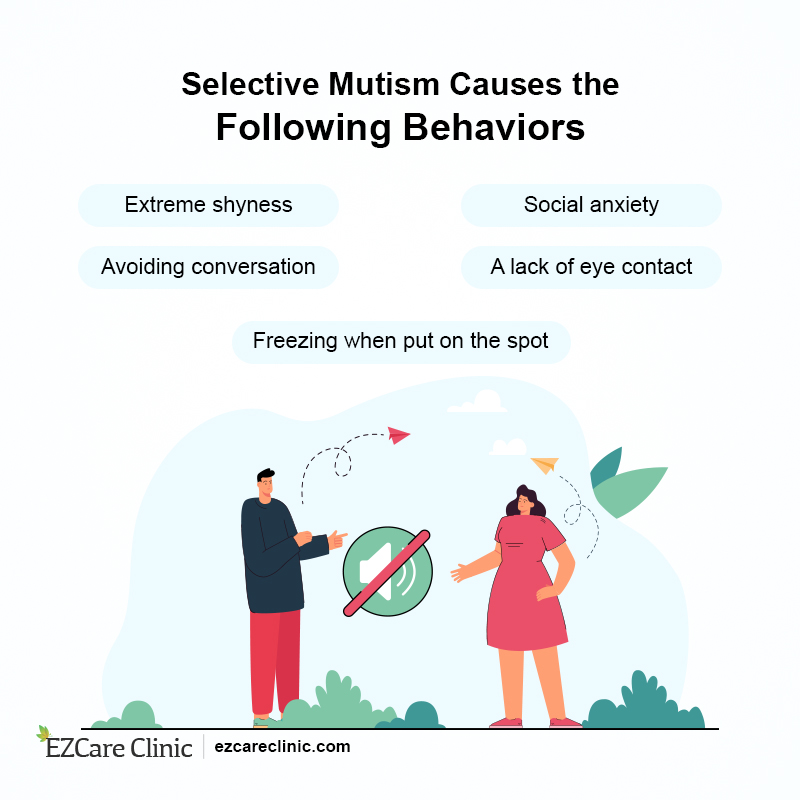
Behaviors Caused by Selective Mutism
-
Clearing the Misconceptions about Selective Mutism
Below are four of the common misconceptions regarding selective mutism:
- It is often mistakenly considered a speech impediment. While some with selective mutism have speech and language problems, most do not. Speech therapy is probably not the best first-line treatment for most patients with selective mutism if they don’t have any signs of speech and language dysfunction.
- Patients with mutism are frequently characterized as stubborn, defiant, and aggressive. For a long time, selective mutism was referred to as elective mutism because it was thought that children were refusing to speak on purpose. Today, we know it is an anxiety disorder that makes people fearful in social situations. While an adult or child with selective mutism might seem angry or hostile, these behaviors reflect their flight or fight response to being in an uncomfortable situation.
- It is a myth that patients with selective mutism just simply refuse to talk. They don’t refuse. Instead, they feel a lack of courage to speak in particular situations.
- People often confuse selective mutism with autism. But it’s important to understand that they’re not the same. Patients with selective mutism often respond by avoiding eye contact, having a blank expression, and being unable to verbally communicate when they are anxious. Children with selective mutism may behave differently in certain situations. But when a child has autism and is nonverbal, they are typically nonverbal in many situations, including those at home, school, or other places.
3. Testing for Selective Mutism in Adults and Differentiating It from Similar Conditions
It is best to detect selective mutism early on. Early intervention can help prevent its negative consequences, such as developing into other severe psychological conditions, such as clinical depression or withdrawal from society. Without early intervention, much of the avoidance behavior associated with selective mutism becomes more of a challenge to resolve.
Identifying the symptoms of selective mutism allows you to reach out for help. A professional assessment can only be done by a mental health professional. However, there are many online psychological tests available that can help detect early signs of selective mutism.
-
Assessment of Current Speaking Behaviors
Selective mutism cannot be diagnosed or ruled out without a thorough understanding of an adult’s or child’s speaking abilities. Therefore, a professional must assess the patient through interviews and direct observations.
To determine how the patient’s communication varies depending on their audience, environment, and speaking situation, the following who, what, where, when, and how factors are considered:
- Who does the adult/child talk to and not talk to? For example, the adult/child may freely talk to their family members and friends. However, they don’t talk to the opposite gender or people from outside their homes.
- What entices the child/adult to talk or causes them to fail to speak? For example, does the adult/child talk if self-initiated, or do they answer yes/no questions but fail to answer open-ended questions.
- Where does the adult/child talk and fail to speak? For example, they talk at home but not in public.
- When does the adult/child talk and fail to speak? For example, they talk when no one is watching, talk when someone from the family is present, and do not talk when someone unfamiliar is present.
- How does the adult/child communicate? For example, they communicate with gestures, whisper to an intermediary, or just freeze and are unable to speak.
Click below to schedule your appointment with a mental health professional.
-
Test for Assessing Selective Mutism and Related Behavior
Most psychological tests for selective mutism are designed for children and not particularly for adults. But the symptoms and criteria for the disorder are the same for both age groups. Therefore, these assessment forms can be modified according to the age group. Some of these tests are available online.
A professional may also test for anxiety or other disorders to better identify and rule out selective mutism and other related conditions, including social anxiety disorder. Some of these tests that may be performed include:
- The selective mutism questionnaire
- The selective mutism stages of the social communication comfort scale
- BASC-3 behavioral and emotional screening system
-
Differentiating Selective Mutism from Similar Conditions
Like many other anxiety conditions, selective mutism is multifaceted. For a definitive diagnosis, the person’s behavior must be distinguished from other similar conditions.
The table below exhibits the characteristics of selective mutism and similar conditions to help differentiate the condition from others.
| Behaviors Characteristic of Similar Conditions | Behaviors Characteristic of Selective Mutism | |
| Autism | The person exhibits atypical social behaviors that are consistent across all social language situations. | The person exhibits atypical social behaviors in some settings but communicates normally in comfortable social settings. |
| Hearing impairment | The person does not hear and therefore does not respond. | The person hears but is unable to respond. |
| Oppositional defiant disorder | The person can speak but refuse out of defiance. | The person may want to speak but is unable out of fear. |
| Second language learning | The person may experience a 3-6 month silent period while learning a new language; the silent period occurs only in the second language learned. | The person does not speak in either the first or second language in certain communication situations. The behavior does not resolve after a 3 to 6-month silent period. |
| Shyness | The person will communicate more freely after a warm-up period of about 15 minutes. The person’s quiet demeanor is consistent in different settings. | The person does not warm up. The person is only shy in certain social situations. |
| Social anxiety disorder | The person fears being judged and hates being the center of attention. | The person may be perfectly willing and eager to be the center of attention when speaking is not expected. |
| Traumatic mutism | The person suddenly stops speaking in most or all settings as the result of a traumatic event. The silence is temporary. | The selective mutism is not the result of trauma and is not temporary. |
The symptoms of social anxiety disorder are treatable- Click below to schedule your appointment with a mental health professional.
4. Types of Selective Mutism
It’s challenging to diagnose mutism. Physical damage to the brain or speech muscles can make a person mute. But sometimes mutism appears from emotional or mental conditions. In other cases, a combination of both reasons can lead to selective mutism. So, to diagnose mutism precisely and accurately, it is further classified into two major types.
Type #1 – Neurogenic Mutism
Neurogenic mutism is a loss of speech caused by an underlying brain injury. It can be temporary or permanent, static or progressive, depending on the affected brain region and the damage’s extent.
Cerebral mutism is another type of neurogenic mutism. Researchers aren’t sure what causes it to occur. It is thought that it might be caused by lesions on the cerebellum that may occur during brain tumor surgery.
Type #2 – Psychogenic Mutism
With psychogenic mutism, a person suddenly stops speaking, but without any injury to the brain. Psychogenic mutism most commonly affects youngsters, but it can also affect adults.
These people can communicate in some situations but not in others, or in other cases with some persons but not with others.
Psychogenic mutism is a chronic disorder that impairs a person’s ability to function in daily life without help. Most people will not grow to recover from this type of mutism without treatment.

Causes of Selective Mutism
-
Types Of Psychogenic Mutism
The classification of psychogenic mutism and the terminologies used to describe have evolved over the years.
Even today, there isn’t complete agreement among experts on how to fully classify psychogenic mutism.
Some of the most typical categories, you’ll hear are:
- Elective Mutism
A person chooses not to speak as a result of psychological issues.
- Selective Mutism
A person wants to speak, but in certain circumstances, finds that they can’t speak.
- Total Mutism
A person doesn’t speak under any circumstance.
| Neurogenic Mutism | Psychogenic Mutism |
| Have physiological basis such as brain injury | Have psychological basis such as trauma |
| Examples include cerebral mutism | Examples include elective mutism, selective mutism, and total mutism |
| Can be long-term and short-term | Can be long-term and short-term |
-
Bilingualism and Selective Mutism
When a person is living abroad or in a bilingual home and learns a new language, it is usual for them to have a period of silence. This is nothing to be concerned about. However, bilinguals and those with immigrant origins are more likely to develop selective mutism.
It is often difficult to diagnose this condition with bi-or-multilingual patients.
Experts recommend looking for the following indicators in such individuals where the mutism:
- Is prolonged
- Isn’t proportionate to the level of second language knowledge and exposure
- Is present in both languages
- Is concurrent with shy or anxious behavior
5. Possible Causes for Selective Mutism in Adults
Experts consider selective mutism as a fear (phobia) of talking to certain people. While the cause is not always clear, it’s often associated with anxiety. Therefore, the adult will typically experience stress and have difficulty dealing with everyday events.
If an adult has a speech and language disorder or hearing problem, it can make it even more stressful to speak.
Another possibility is that they have trouble processing sensory information because of loud noises and various activities going on in a crowded atmosphere. This is a condition known as sensory integration dysfunction.
This can make them shut down because they are overwhelmed with the noise and activity and cannot speak. Their anxiety can then transfer to other people they are with or attempting to interact with.
Get the causes of selective mutism under control- Click below to schedule your appointment.
-
Etiological Theories for Selective Mutism
Here we will discuss the most common theories as to why selective mutism may develop:
- Psychodynamic Theory
The psychodynamic theory links the cause of selective mutism with past unresolved emotional conflicts. In selective mutism, it is assumed that the patient has an oral fixation or has regressed to a non-verbal developmental stage.
It is considered a coping method for dealing with anger or anxiety. At this time there is little research to support this view: therefore, it is not considered a valid theory by many experts.
- Behavioral Theory
In behavioral theory, refusing to speak is a learned strategy for managing one’s environment in response to social stimuli. As a result, it is based on negative reinforcement learning and is considered an adaptive response in adults rather than a disease or condition.
This perspective is significant because it frames selective mutism as an anxiety symptom instead of purposefully manipulative behavior.
- Social Phobia or Anxiety
Presently, selective mutism has been explained in the context of social phobia. In this view, selective mutism is a type of social phobia that is marked by extreme social anxiety. Adults with social phobia tend to avoid public speaking and behave in ways attributed to selective mutism.
Continued unwillingness to communicate indicates anxiety in this context. The hypothesis suggests that selective mutism may be part of a continuum that also includes childhood speech, inhibition, and social anxiety disorder.
- Family Systems Theory
The family systems model is another common theory thought to be behind selective mutism. This perspective is based on the belief that some children experience neurotic relationships with their parents (most often the mother).
Typically, parents show an excessive need to control their child, along with an associated dependence and uncertainty.
Their children then develop intense unhealthy attachments like:
- Increased dependency
- Fear
- Distrust of the outside world
- Fear of strangers
- Language and assimilation difficulties
- Delayed speech
- Dissociative Identity Theory
Selective mutism may also be explained by dissociative identity disorder.
For example, Jacobsen claims that a 15-year-old boy who had multiple identities and suffered from selective mutism couldn’t talk to other people because he was afraid of being noticeable and sharing information about a murder he observed while assuming his different identities.
This was a unique situation because the patient had suffered from selective mutism for years and was older than the typical onset age of 5 years.
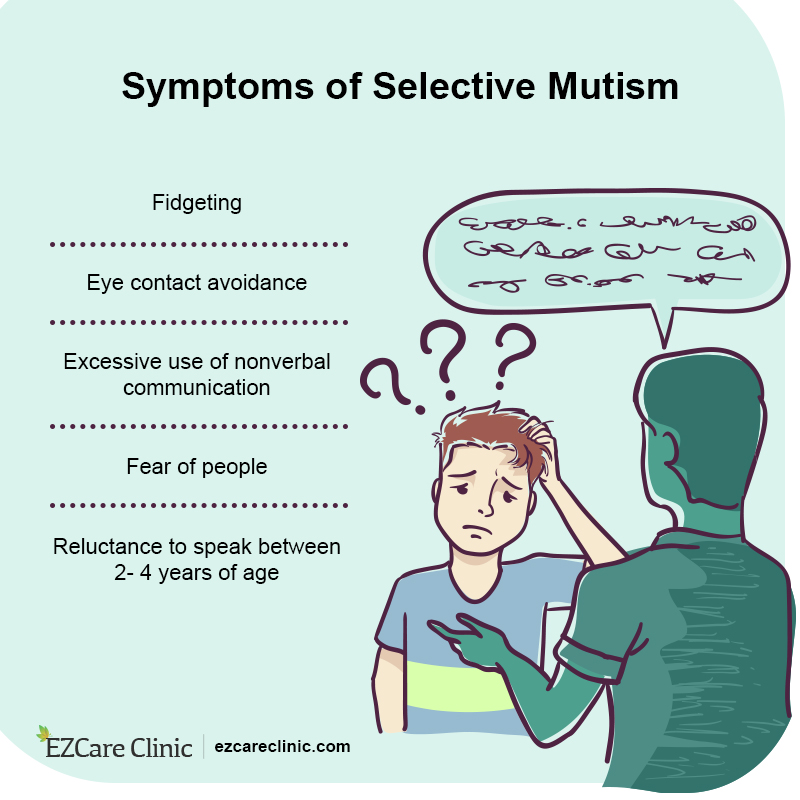
Symptoms of Selective Mutism
- Post-Traumatic Stress Theory
The risk of selective mutism has been linked to post-traumatic stress disorder with dissociative features. It is considered a rare cause of selective mutism. However, there are many examples of children who experienced abuse and trauma and are diagnosed with selective mutism later in life.
Intrusive thoughts, violent play, trauma-related dreams, and flashbacks are common symptoms for children with PTSD. Their internal coping mechanism after a traumatic event could stop them from speaking.
- Developmental Psychopathology Theory
The developmental psychopathology theory is a relatively new concept. This theory supports the idea that children with early speech and language deficits who are unaware of these deficiencies when they attend school are then teased by other children who have adequate language skills.
The taunting from other children could set off a habit of avoidance that leads to mutism for some children that have nervous tendencies. This theory views selective mutism as an avoidance behavior rather than an illness and emphasizes environmental circumstances interacting with
6. Treating Adults With Selective Mutism
What should you do if you think you could be suffering from selective mutism? You should get help and support from a mental health professional as soon as possible.
Early detection and treatment for this condition could significantly boost your chances of overcoming it or greatly improve your symptoms.
Even if you’re an adult with selective mutism, treatment is still possible. However, it may take longer because, over time, your condition’s behaviors may have become more deep-rooted.
Having a coexisting mental health condition such as depression, anxiety disorder or a learning disability that affects your communication capacity is another avenue to consider when seeking treatment.
The length and complexity of your treatment program may be affected if you suffer from another mental health condition.
Here are some of the most common treatments used to treat patients with selective mutism:
-
Cognitive-Behavioral Therapy (CBT)
CBT is one of the most effective ways to treat symptoms of selective mutism.
It is an action-oriented, problem-solving talking therapy where you or your child can better understand the disorder and anxiety.
The therapist will teach you or your child different techniques for managing stress in triggering situations and focus on how negative thoughts and feelings can contribute to anxiety symptoms.
Schedule an appointment with a mental health professional to see which selective mutism treatment works the best for you- Click below.
-
Behavioral Techniques
Several behavioral strategies are used in CBT, along with the cognitive insight of your thinking pattern and disorders.
But when these strategies are used together, they’re most effective at identifying and improving patients speaking skills for long-term benefits:
- Systematic desensitization is a technique that uses relaxation techniques while gradually exposing yourself to more anxiety-provoking events. A hierarchy of feared speaking events is built in this intervention style. This therapy comprises a sequence of imagined and real-life exposure to dreaded scenarios.
- Shaping of behavior is done through two-way communication with people who aren’t close friends or family members. It also employs techniques that gradually lead to goals such as reading aloud or taking part in interactive reading games. This is done before moving on to face-to-face communication once you’re ready. It is very effective for treating selective mutism.
- Social skills training is also used to reduce fear and facilitate speech with others. It includes learning how to start a conversation, taking turns, managing eye contact, and understanding another person’s nonverbal cues.
- Self-modeling involves creating movies or audio records that have been altered/edited to show adults speaking in situations where they previously kept silent. The videos are played regularly throughout the intervention to help the patient become accustomed to hearing themself talking in various circumstances.
-
Medication for Selective Mutism
Medications for selective mutism are only appropriate for adolescents, adults, and people with other mental health issues that have resulted in or coincided with the problem, such as depression.
Antidepressants can help ease anxiety and depression symptoms for behavior therapy to work, especially if previous treatments haven’t been successful.
An adult’s inability to talk in specific settings can be treated with medicine prescribed by a psychiatrist.
Medication is most helpful when used in conjunction with the behavioral or other psychological treatments mentioned above, and helps you maintain progress in your communication skills over time.
SSRIs (selective serotonin reuptake inhibitors) have been shown to be helpful in youth with anxiety disorders.
-
Speech-Language Therapy
Speech-language pathologists (SLPs) may contribute to the treatment of people with selective mutism if speech or language impairments also exist.
SLPs are trained to work with a pragmatic language that could be significantly affected in people with selective mutism.
Simultaneous treatment using both behavioral strategies can help patients with selective mutism feel more comfortable speaking and take part in recommended linguistically based activities to foster language development.
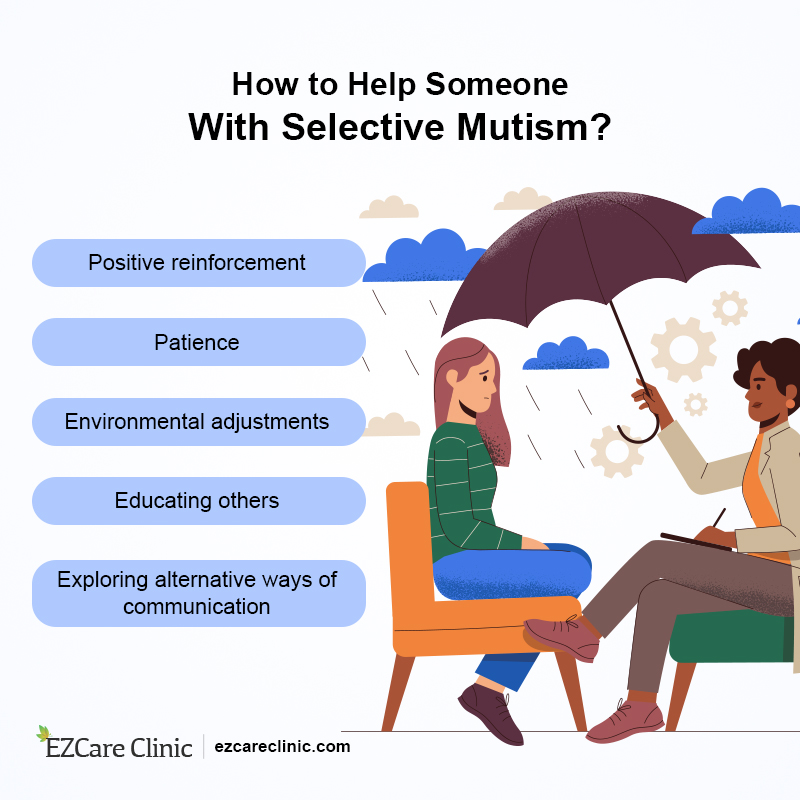
How to Help Someone With Selective Mutism
7. 5 Helpful Tips for Managing Selective Mutism
Selective mutism can be frightening. Social anxiety is a source of selective mutism in adulthood. Therefore, learning skills to manage it and progressively expose yourself to social situations could make a dramatic difference in your life.
Don’t worry if you’re feeling a little overwhelmed. Everyone’s situation is unique. You’ll get the best result if you take your time and move through treatment at your own pace. Meanwhile, these five tips can help you manage your selective mutism.
Tip #1: Reward Yourself on Achievements
Reward yourself for speaking up or confronting social anxiety. Your selective mutism is challenging to overcome. Therefore, you deserve a reward whenever you have a successful conversation with someone or face a difficult social circumstance.
Rewarding yourself encourages you to continue working on improving your social abilities. Create a set of incentives for yourself, such as eating a piece of candy, purchasing yourself a special gift, or playing a video game you enjoy.
For example, on your way home from the office, stop and buy your favorite coffee or drink. But only do it if you order it in person.
You might also keep your favorite snack at your desk at work and treat yourself every time you speak with someone who makes you uncomfortable.
Tip #2: Talk to Someone You Are Comfortable With
Try stimulus fading to get more comfortable with talking to people. During a stimulus fading exercise, you’ll speak to someone you feel comfortable with and then transition to a conversation with someone you don’t know well.
- Start a one-on-one conversation with someone you’re able to talk to.
- Someone you struggle to speak with will join you during your discussion, then the first person will leave.
- Do your best to continue the conversation with the new person.
It’s okay if you freeze up when the new person comes into the room. Just keep trying until you’re successful.
Tip #3: Expose Yourself to Social Situations
Even if you’re not comfortable chatting, put yourself in social circumstances. If you avoid social settings, your social anxiety will continue to increase. Going out in public and attending social activities might be a little frightening at first.
But gradually, you will gain confidence in your ability to interact with others. Don’t worry about making small talk; just spend time with folks you’re unfamiliar with.
Clever ways to expose yourself to social situations include:
- Attending a party that you are invited to
- Walking around the grocery store or local shopping center
- Going to holiday festivities organized by family or friends
Tip #4: Don’t Put Yourself Under Excessive Pressure
If you aren’t ready, don’t pressure yourself to talk. It can be very overwhelming when you feel like you must speak. This makes it even harder to overcome your selective mutism. Instead, tell yourself that you’ll try to talk, but it’s okay if it doesn’t happen this time.
Eventually, this will help you feel less anxious about social situations. Of course, you should still always try to talk if you can. But don’t feel obligated or beat yourself up if you cannot do it.
Tip #5: Learn Non-Verbal Gestures to Help You With Selective Mutism
You can communicate without talking by using nonverbal communication techniques, such as pointing, nodding, or miming. Practice using different gestures that can help you express what you need. Keep track of what works and what doesn’t to assist you in the future.
For instance, you:
- Might point to the item to show that you need it
- Could use a thumbs up or thumbs down to say yes or no
- May wave hello and goodbye to coworkers instead of saying it
The symptoms of selective mutism can be overcome. Click below to schedule your appointment with a mental health professional.
Some Final Thoughts on Selective Mutism
Despite being an anxiety disorder often associated with children, selective mutism can continue into adulthood. It is a real condition.
When left untreated, it can have negative consequences throughout an individual’s life and, unfortunately, set them up for a variety of academic, social, and emotional disappointments.
So, if you or your loved one is suffering from selective mutism, make sure to seek professional help as soon as possible.
Sources
- Asthma in remission: can relapse in early adulthood be predicted at 18 years of age? (2005)
Source link - What does it mean to have a genetic predisposition to a disease?
Source link - Review of Behavioral Principles in Communicative Disorders by Maul, Findley, and Adams. (2018)
Source link
Click below to schedule your appointment with a professional at EZCare Clinic.
